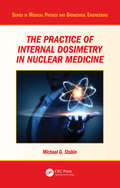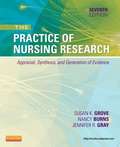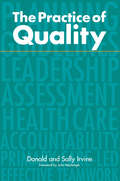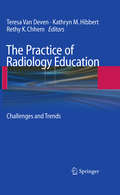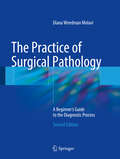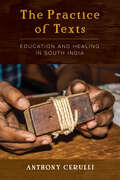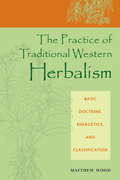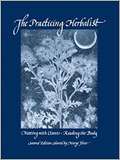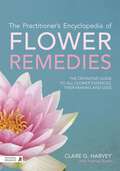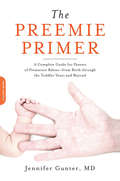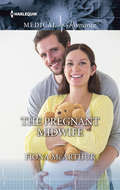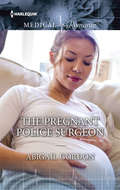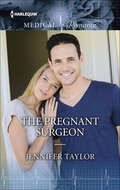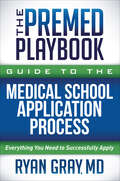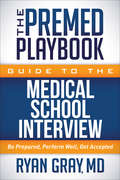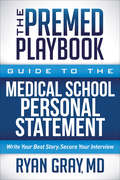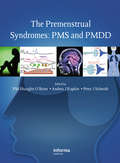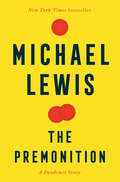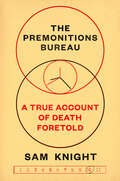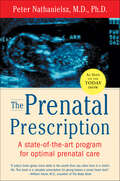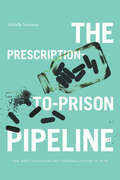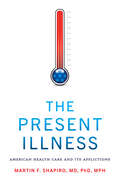- Table View
- List View
The Practice of Internal Dosimetry in Nuclear Medicine (Series in Medical Physics and Biomedical Engineering)
by Michael G. StabinWritten by one of the world's leading experts in the field of nuclear medicine dosimetry, this text describes in detail the use of internal dose calculations in the practice of nuclear medicine. While radiation therapy with external sources of radiation always employs calculations of dose to optimize therapy for each patient, this is not routinely conducted in nuclear medicine therapy. As the trend towards an increasing role of dosimetry in therapy planning increases, this book reviews the available methods and technologies available to make this a more common practice. The book begins by covering the mathematical fundamentals of internal dose calculations, and uses sample calculations to demonstrate key principles. The book then moves forward to describe anthropomorphic models, dosimetric models, and types and uses of diagnostic and therapeutic radiopharmaceuticals. The depth of coverage makes it useful reference and guide for researchers performing dose calculations and for physicians considering incorporating dose calculations into the treatment of their cancer patients.
The Practice of Nursing Research: Appraisal, Synthesis, and Generation of Evidence (7th Edition)
by Susan K. Grove Nancy Burns Jennifer R. GrayLearn how to properly evaluate and use existing research data and how to conduct your own original research. This authoritative text gives provides a comprehensive foundation for appraisal, synthesis, and generation of research evidence for clinical nursing practice. This new edition also features enhanced coverage of the research methods most applicable to evidence-based practice (outcomes research, intervention research, and translational research), along with a significant increase in the coverage of qualitative research methodologies. Comprehensive coverage of nursing research organizes content into five units: Introduction to Nursing Research, Nursing Research Processes, Tools for Evidence-Based Healthcare, Strategies for Analyzing Research and Building an Evidence-Based Practice, and Writing Proposals and Obtaining Funding. Rich and frequent examples from the literature demonstrate the importance and immediacy of research in nursing practice and bring principles to life through the context of actual published studies. Strong coverage of quantitative and other clinically-applicable research methodologies gives you a solid grounding to conduct, appraise, and apply research evidence to the realities of clinical practice in today's healthcare environment. NEW! Enhanced emphasis on evidence-based practice equips you to generate research evidence and to appraise and synthesize existing research for application to clinical practice. Using the ANCC Magnet Recognition Program criteria as a point of focus, this book prepares you for today's emphasis on evidence-based practice in the clinical setting. NEW! Expanded emphasis on qualitative research addresses phenomenological research, grounded theory research, ethnographic research, exploratory-descriptive research, and historical research to support the development of nursing. NEW! Updated coverage of digital data collection guides you through use of the internet for research and addresses the unique considerations surrounding digital data collection methods. NEW! Pageburst ebook study guide gives you the opportunity to fully master and apply the text content in a convenient electronic format with integrated interactive review questions.
The Practice of Quality: Changing General Practice (Higher Education Is Facing Fundamental Questions About Financing, Affordability, Access, Quality, Outcomes, And Diversity. College And University Administrators, As Well As State And Federal Policymakers, Need Reliable Data, Effective Interpretation Of Research, Innovative Ideas, And Cogent Analysis To Guide Them In The Critical Decisions They Will Be Facing In The Near And Long Term. The Series B)
by Sally Irvine Donald IrvineThis work adopts a modern approach to quality assurance and quality improvement in general practice. It provides an introduction to the subject, enabling readers to see how best to proceed in their own practices. It revises and updates previous books by Donald and Sally Irvine on clinical audit by placing audit within the wider quality context. It is designed to provide an easily accessible approach to the basic tenets as well as speculating on the future developments in this area, and should be of interest to all members of the practice team. The themes of the book are illustrated by reference to the five major case studies provided, which describe in some detail the various ways of starting, implementing and maintaining quality assurance in general practice today. Practical examples of Total Quality Management, the use of British Standard 5750, Kings Fund organizational audit, Investors in People, and Fellowship of the Royal College of General Practitioners by assessment, are also provided. These studies are written by the practitioners, medical and non-medical, who have themselves been through the experience of turning theory into practice.
The Practice of Radiology Education
by Kathryn M. Hibbert Teresa Van Deven Rethy K. ChhemThe role of medical imaging is increasingly integral to health care, drug discovery, biology, and other life sciences. The changes that are occurring call for innovation in the training of the medical imaging experts of tomorrow. In their previous book, Radiology Education: The Scholarship of Teaching and Learning (2008), the editors addressed the philosophical and theoretical underpinnings of scholarship in radiology education. Now, in The Practice of Radiology Education: Challenges and Trends, they focus on the application of these concepts within educational programs for radiology residents and fellows. The contributors are educators in radiology from around the world, providing a global perspective on the main challenges facing medical imaging education and the potential strategies required to meet these challenges. It is hoped that the book will assist in attaining the ultimate goal of radiology education: to help patients.
The Practice of Surgical Pathology: A Beginner's Guide To The Diagnostic Process
by Diana Weedman MolaviIn pathology education within North America, there exists a wide gap in the pedagogy between medical school and residency. As a result, the pathology intern often comes into residency unprepared. Completely illustrated in color, this book lays the foundation of practical pathology and provides a scaffold on which to build a knowledge base. It includes basic introductory material and progresses through each organ system. Within each chapter, there is a brief review of salient normal histology, a discussion of typical specimen types, a strategic approach to the specimen, and a discussion of how the multitude of different diagnoses relate to each other.
The Practice of Texts: Education and Healing in South India
by Anthony CerulliThe Practice of Texts examines the uses of the Sanskrit medical classics in two educational institutions of India’s classical life science, Ayurveda: the college and the gurukula. In this interdisciplinary study, Anthony Cerulli probes late- and postcolonial reforms in ayurvedic education, the development of the ayurvedic college, and the impacts of the college curriculum on ways that ayurvedic physicians understand and use the Sanskrit classics in their professional work today. His fieldwork in south India illuminates the nature of philology and ritual in the ayurvedic gurukula and showcases how knowledge is exchanged among students, teachers, and patients. The result, Cerulli shows, is that the Sanskrit classics are presented and applied differently in the college and gurukula, producing a variety of relationships with these texts among practitioners. By interrogating the politics surrounding the place of the Sanskrit classics in ayurvedic curricula, this book reveals a spectrum of views about the history and tradition of Ayurveda in modern India.
The Practice of Traditional Western Herbalism: Basic Doctrine, Energetics, and Classification
by Matthew WoodThe Practice of Traditional Western Herbalism places the function of western herbs in their true historical context, apart from homeopathy, traditional Chinese medicine, and Ayurveda. Recently there has been a revival of interest in western herbalism, but practitioners haven't been able to explore its benefits due to a void of information on the topic--the system of medicine the herbs fit into had all but disappeared. To remedy the situation, herbalist Matthew Wood has researched the old-time practices and reconstructed them for modern use. In resuscitating western herbal medicine and bringing it up to date, he gives his readers a powerful tool for holistic theory and treatment. Wood makes the point that plant medicines, because they are made from a broad range of chemical components, are naturally suited for the treatment of general patterns in the body. He argues against the biomedical model of standardization, in which herbs are refined and advertised as if they were drugs suited to an exact disease or condition.
The Practice of Tui Na: Principles, Diagnostics and Working with the Sinew Channels
by Robert AspellTui Na is one of the 'Four Pillars' of Chinese medicine (alongside Acupuncture, herbal medicine and Qi Gong) and is a form of bodywork that includes acupressure, massage techniques, assisted stretching, and joint mobilisations or adjustments that are all based on the key medical principles and diagnostics of the Classics of Chinese medicine. This book is an accessible clinical handbook of Tui Na principles and practice.Tui Na can be used as much more than a musculoskeletal therapy, but in order to use it to its full potential as a medical intervention, it is essential to understand its uses on the Sinew channel system as opposed to the other channel systems commonly used within acupuncture. Tui Na requires an understanding of the principles and pathways of the Sinew channels as a standalone system of the body, as well as its relationship to the other channel and organ systems, and this book provides an accessible introduction to these channels before moving onto Tui Na practice. There are Sections on Diagnosis and Assessment, Techniques and Treatments with hand and joint manipulation techniques covered in detail, along with instruction on developing a Tui Na prescription and protocols for the treatment of common conditions.This book can be used by beginners studying on a hands-on practical course in Tui Na, in addition to qualified Chinese medicine and Tui Na practitioners.
The Practicing Herbalist: Meeting with Clients, Reading the Body
by Margi FlintThe Practicing Herbalist : Meeting with Clients, Reading the Body
The Practitioner's Encyclopedia of Flower Remedies: The Definitive Guide to All Flower Essences, their Making and Uses
by Richard Gerber George Lewith Clare G. HarveyThis comprehensive encyclopedia brings together flower essences gathered from all corners of the globe, from Hawaii and the Himalayas to America and the Australian Bush. It explains what flower remedies are, how they work and how to choose the right remedies for your clients' needs. The properties of 33 families of flower essences and the benefits of over 2,000 remedies, combinations, mists and creams are described. An easy-to-use ailment chart pinpoints remedies for a wide range of physical and psychological conditions, from stress to hormonal imbalance and from allergy to depression. The author provides instructions for prescribing, preparing and using flower remedies alongside illustrative patient case studies. This will be the definitive handbook for practitioners, therapists and students of complementary and alternative therapies working with flower essences and will be valuable reading for those wanting to learn more about how they can use flower essences in their practice.
The Preemie Primer: A Complete Guide for Parents of Premature Babies -- from Birth through the Toddler Years and Beyond
by Jennifer GunterHaving a premature baby-a baby born before the thirty-seventh week of pregnancy- can be a crash course in both medicine and health economics, not just in parenting. Parents face complex information, difficult decisions, and overwhelming grief and worry-with challenges that often extend well beyond those early days and weeks. As an ob/gyn, Dr. Jennifer Gunter has delivered hundreds of premature babies, but as a mother of preemie triplets, she also understands the heartbreak and challenges of prematurity. The Preemie Primeris a comprehensive resource, covering topics from delivery, hospitalization, and preemie development to parenting multiples, handling health issues, and finding special-needs programs. Compassionate, engaging, and medically grounded,The Preemie Primeris the first book on prematurity to combine the insight of a doctor with the experience of a mom.
The Pregnancy Proposition
by Meredith WebberNurse Amelia Peterson's relationship with bad-tempered E.R. doctor "Mac" McDougal has always been rocky. So she's astonished when he asks her out for dinner one night…and even more surprised when she wakes up with him the next morning! The ill-matched pair are both sure it was a one-off — no matter how much they might find themselves desiring each other! But, while Mac doesn't do relationships, he has always wanted a child — and when he realizes that Amelia's pregnant, he comes up with the most unexpected proposal….
The Pregnant Midwife
by Fiona McarthurExpecting the doctor's baby! Courageous midwife Kirsten Wilson has been trying to forget Hunter Morgan since returning to Sydney. Getting up in the helicopter again to rescue tiny babies is just what she needs to put their past behind her. At least until Hunter arrives as the new doctor in charge! Hunter's still attracted to Kirsten, but he can't bring himself to commit to someone so feisty and daring. That is until a huge helicopter crash forces them to put their priorities in order--and the consequences change both their lives forever....
The Pregnant Police Surgeon
by Abigail GordonA father for her child?General practitioner and local police surgeon Dr. Imogen Rossiter is impetuous, fiery, beautiful... and pregnant! When she meets fellow G.P. and police surgeon Dr. Blair Nesbitt, sparks fly between them. Until Imogen tells him she is carrying another man's child.Blair is devastated, yet filled with a desire to protect Imogen and her unborn child--he even proposes marriage! They are both thrown into an emotional turmoil making any relationship between them seem impossible, except fate takes a hand and tests the strength of their love for each other once and for all....
The Pregnant Surgeon
by Jennifer TaylorThe last two things she ever expected—a man and a baby!Sacrificing her personal life to become a high-flying surgeon has left Joanna Martin with few regrets. She has learned not to risk heart for any man—including her new senior registrar, Dylan Archer, even though her secret desire for him is as strong as her drive to succeed…Dylan's determination to impress and break throughhis beautiful boss's cool exterior, both in and out ofthe operating theater, finally results in one nightof passion. But convincing her that theycould have a future together remains achallenge. Then Joanna discoversshe is pregnant…
The Premed Playbook Guide to the Medical School Application Process: Everything You Need to Successfully Apply
by Ryan GrayThe fourth installment of The Premed Playbook series brings together all of the wisdom of helping thousands of students through the medical school application process.
The Premed Playbook Guide to the Medical School Interview: Be Prepared, Perform Well, Get Accepted (The\premed Playbook Ser.)
by Ryan Gray“A must-have for every future doctor’s collection. Great advice, comprehensive, and to the point. Dr. Gray breaks it down, play by play.” —Sujay Kansagra, MD, author of The Medical School ManualThe Premed Playbook Guide to the Medical School Interview is the only book needed to prepare premed students for their medical school interviews. Through interviews with Admissions Committee members and others, Dr. Gray has compiled the most comprehensive book on this subject. Premed students want to know what to expect, but more importantly they need to see examples of what successful applicants have done. The Premed Playbook not only gives them close to six hundred potential interview questions, it also gives them real answers and feedback from interview sessions that Dr. Gray has held with students.“This book touches on every aspect of the interview from applying, during the interview and things to do/not to do after the interview. I highly recommend this book for every student to read and have available for reference during the medical school interview season.” —Antonio J. Webb, MD, orthopedic resident surgeon, motivational speaker, and author of Overcoming the Odds“He challenges the reader to examine their strengths and weaknesses and gives them a blueprint on how to put their best foot forward. His advice is real-world and complied by many interviewers, including myself, who have years of experience interviewing medical school applicants. I highly recommend this book as a fundamental preparation tool for the application process.” —Gregory M. Polites, MD, Associate Professor of Emergency Medicine, Chairman of the Central Subcommittee on Admissions, Washington University School of Medicine
The Premed Playbook: Guide to the Medical School Personal Statement (The\premed Playbook Ser.)
by Dr. Ryan GrayThe Premed Playbook: Guide to the Medical School Personal Statement helps guide students in crafting their stories for the medical school Admission Committees. It's not only a collection of essays from students who got into top schools, but is a showcase of essays that started badly and were honed to tell great stories. Ryan Gray, MD shares the stories of students who likely didn&’t have a shot, but ultimately succeed, in part because of the advice laid out in The Premed Playbook: Guide to the Medical School Personal Statement. They had to fight their way into medical school—and told a great story to do it.
The Premenstrual Syndromes: PMS and PMDD
by Pm Shaughn O’Brien Andrea J Rapkin Peter J SchmidtThis text is definitive, scientific, readable, and offers a reference and text for specialist gynecologists, psychiatrists, and psychologists working at a high level in their respective professions. It is an academic text of the highest level being authoritative and comprehensive.It has the correct balance between the specialties of psychiatry
The Premonition: A Pandemic Story
by Michael LewisNew York Times Bestseller For those who could read between the lines, the censored news out of China was terrifying. But the president insisted there was nothing to worry about. Fortunately, we are still a nation of skeptics. Fortunately, there are those among us who study pandemics and are willing to look unflinchingly at worst-case scenarios. Michael Lewis’s taut and brilliant nonfiction thriller pits a band of medical visionaries against the wall of ignorance that was the official response of the Trump administration to the outbreak of COVID-19. The characters you will meet in these pages are as fascinating as they are unexpected. A thirteen-year-old girl’s science project on transmission of an airborne pathogen develops into a very grown-up model of disease control. A local public-health officer uses her worm’s-eye view to see what the CDC misses, and reveals great truths about American society. A secret team of dissenting doctors, nicknamed the Wolverines, has everything necessary to fight the pandemic: brilliant backgrounds, world-class labs, prior experience with the pandemic scares of bird flu and swine flu…everything, that is, except official permission to implement their work. Michael Lewis is not shy about calling these people heroes for their refusal to follow directives that they know to be based on misinformation and bad science. Even the internet, as crucial as it is to their exchange of ideas, poses a risk to them. They never know for sure who else might be listening in.
The Premonitions Bureau: A True Account of Death Foretold
by Sam Knight&“This is rich, florid, funny history, with undertones of human grief . . . Knight is shrewd and perceptive . . . [he] pushes his material into neurobiology, into the nature of placebos and expectations and self-fulfilling prophecies . . . Knight&’s book is crisp.&” —Dwight Garner, New York Times&“Stunning… An enveloping, unsettling book, gorgeously written and profound.&” —Patrick Radden Keefe, New York Times bestselling author of Say Nothing and Empire of Pain From a rising star New Yorker staff writer, the incredible and gripping true story of John Barker, a psychiatrist who investigated the power of premonitions—and came to believe he himself was destined for an early deathOn the morning of October 21, 1966, Kathleen Middleton, a music teacher in suburban London, awoke choking and gasping, convinced disaster was about to strike. An hour later, a mountain of rubble containing waste from a coal mine collapsed above the village of Aberfan, swamping buildings and killing 144 people, many of them children. Among the doctors and emergency workers who arrived on the scene was John Barker, a psychiatrist from Shelton Hospital, in Shrewsbury. At Aberfan, Barker became convinced there had been supernatural warning signs of the disaster, and decided to establish a &“premonitions bureau,&” in conjunction with the Evening Standard newspaper, to collect dreams and forebodings from the public, in the hope of preventing future calamities.Middleton was one of hundreds of seemingly normal people, who would contribute their visions to Barker&’s research in the years to come, some of them unnervingly accurate. As Barker&’s work plunged him deeper into the occult, his reputation suffered. But in the face of professional humiliation, Barker only became more determined, ultimately realizing with terrible certainty that catastrophe had been prophesied in his own life.In Sam Knight&’s crystalline telling, this astonishing true story comes to encompass the secrets of the world. We all know premonitions are impossible—and yet they come true all the time. Our lives are full of collisions and coincidence: the question is how we perceive these implausible events and therefore make meaning in our lives. The Premonitions Bureau is an enthralling account of madness and wonder, of science and the supernatural. With an unforgettable ending, it is a mysterious journey into the most unsettling reaches of the human mind.
The Prenatal Prescription
by Christopher Vaughan Peter NathanielszDid you know that your actions during pregnancy impact your child's health after birth and into adulthood? That what you eat, how much you exercise, your stress level, and your immediate environment are all key factors in determining your baby's predisposition to such conditions as heart disease, obesity, diabetes, stroke, cancer, even depression? Based on more than thirty years of rigorous scientific research, Dr. Nathanielsz's The Prenatal Prescription explains why this is so and what you can do about it.Focusing on the main factors that directly affect the unborn child -- nutrition, stress, toxins, and exercise -- Dr. Nathanielsz lays out a clear and easy-to-follow program for "prenatal programming." He explains the science behind the fetal origins of adult disease, and offers tools that you can use to make your prenatal interaction with your baby memorable and beneficial.Starting before conception, this simple prescription will change forever the way you think about preparing yourself for pregnancy. All parents want a long and healthy life for their child. The Prenatal Prescription explains how to make this a reality.
The Prescriber's Guide: Stahl's Essential Psychopharmacology
by Stephen M. Stahl Meghan M. Grady Nancy MuntnerPrescriber's Guide spin-off covering the most important drugs in use today for treating depression.
The Prescription-to-Prison Pipeline: The Medicalization and Criminalization of Pain
by Michelle SmirnovaIn The Prescription-to-Prison Pipeline Michelle Smirnova argues that the ongoing opioid drug epidemic is the result of an endless cycle in which suffering is medicalized and drug use is criminalized. Drawing on interviews with eighty incarcerated individuals in Missouri correctional institutions, Smirnova shows how contradictions in medical practices, social ideals, and legal policies disproportionately criminalize the poor for their social condition. This criminalization further exacerbates and perpetuates drug addiction and poverty. Tracing the processes by which social issues are constructed as biomedical ones that necessitate pharmacological intervention, Smirnova highlights how inequitable surveillance, policing, and punishment of marginalized populations intensify harms associated with both treatment and punishment, especially given that the distinctions between the two have become blurred. By focusing on the stories of people whose pain and pharmaceutical treatment led to incarceration, Smirnova challenges the binary of individual and social problems, effectively exploring how the conceptualization, diagnosis, and treatment of substance use may exacerbate outcomes such as relapse, recidivism, poverty, abuse, and death.
The Present Illness: American Health Care and Its Afflictions
by Martin F. ShapiroBeyond political posturing and industry quick-fixes, why is the American health care system so difficult to reform?Health care reform efforts are difficult to achieve and have been historically undermined by their narrow scope. In The Present Illness, Martin F. Shapiro, MD, PhD, MPH, weaves together history, sociology, extensive research, and his own experiences as a physician to explore the broad range of afflictions impairing US health care and explains why we won't be able to fix the system without making significant changes across society. With a sharp eye and ready humor, Shapiro dissects the ways all groups participating—clinicians and their organizations, medical schools and their faculty, hospitals and clinical corporations, scientists and the National Institutes of Health, insurers and manufacturers, governments and their policies, and also patients and the public—shape and reinforce a dysfunctional system. Shapiro identifies three major problems stymieing reform: commodification of care; values, expectations, unmet needs, attitudes, and personal limitations of participants; and toxic relationships and communication among these groups.Shapiro lays out a sweeping agenda of concrete actions to address the many factors contributing to the system's failings. Highlighting the interconnectedness of both the problems and potential solutions, he warns that piecemeal reform efforts will continue to be undermined by those who believe they have something to gain from the status quo. Although overhauling our health care system is daunting, Shapiro nonetheless concludes that we must push forward with a far more comprehensive effort in all sectors of health care and throughout society to create a system that is humane, effective, and just.
